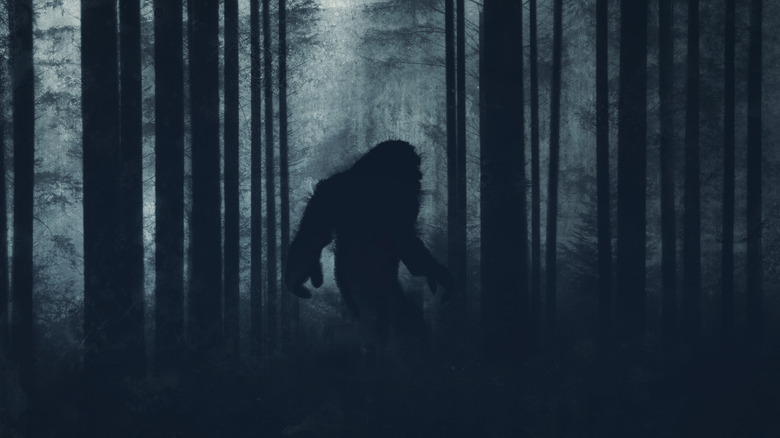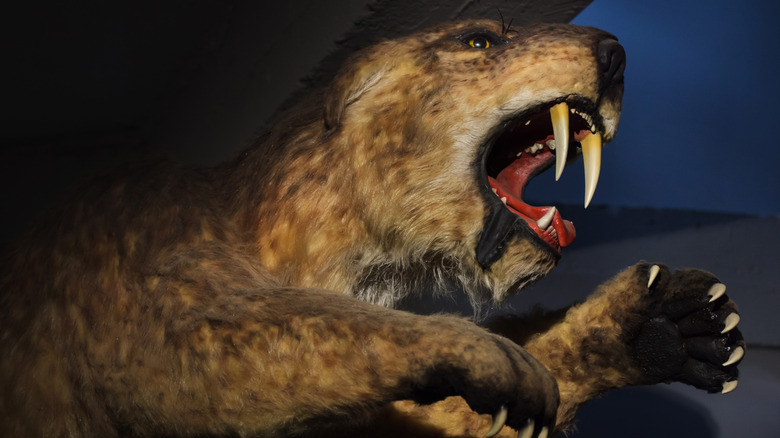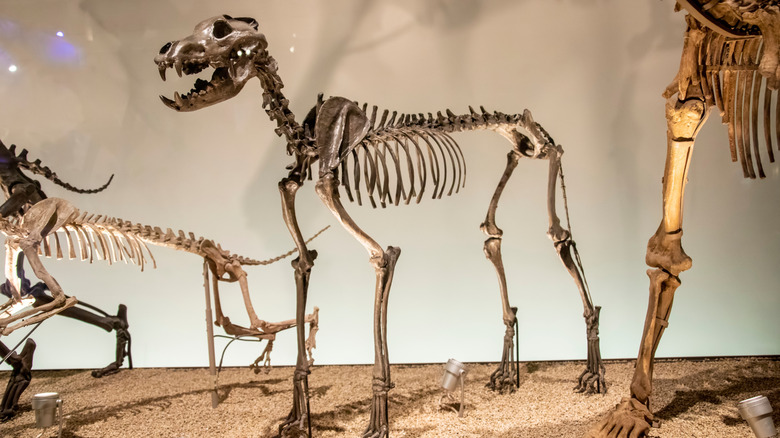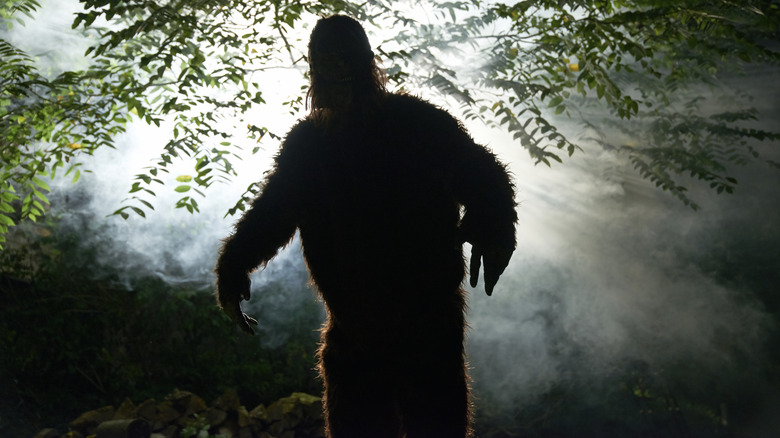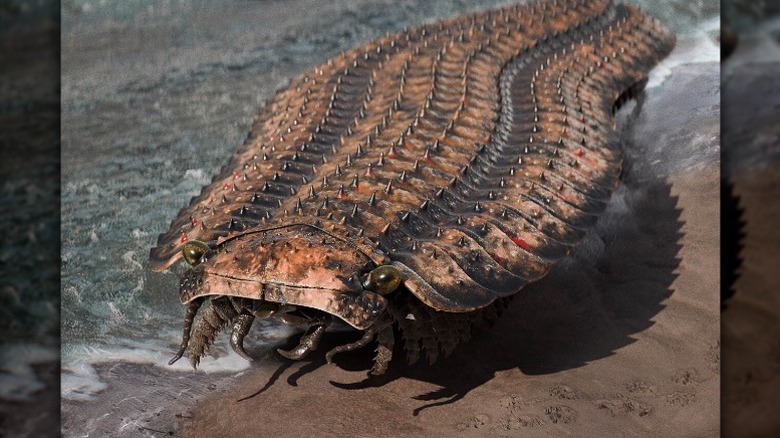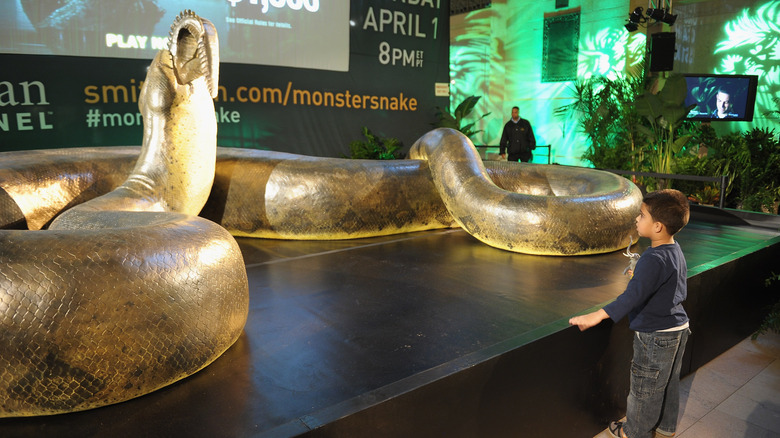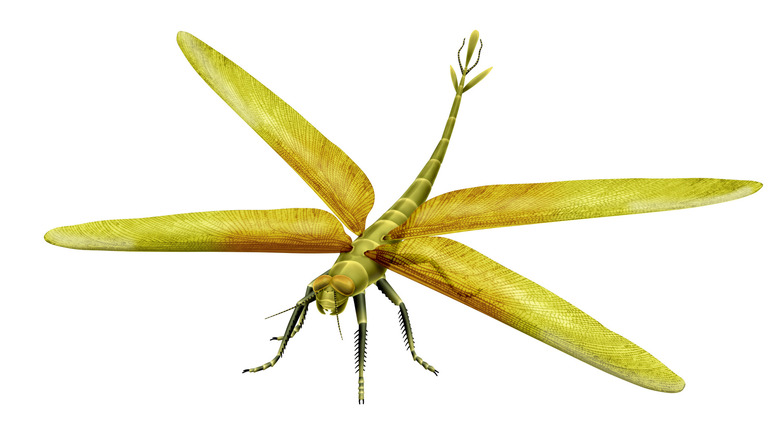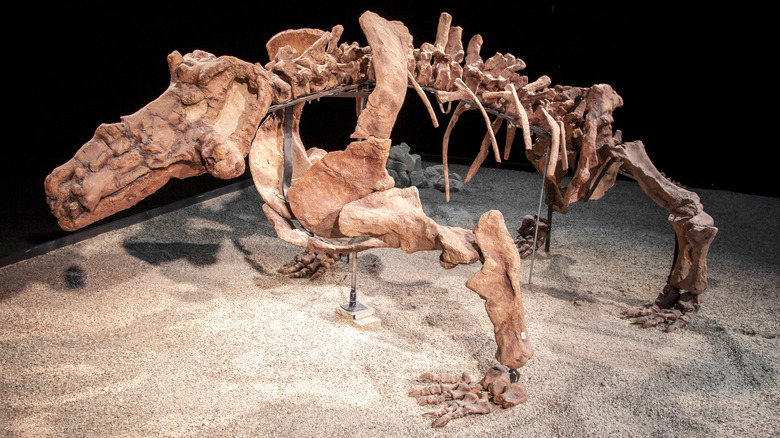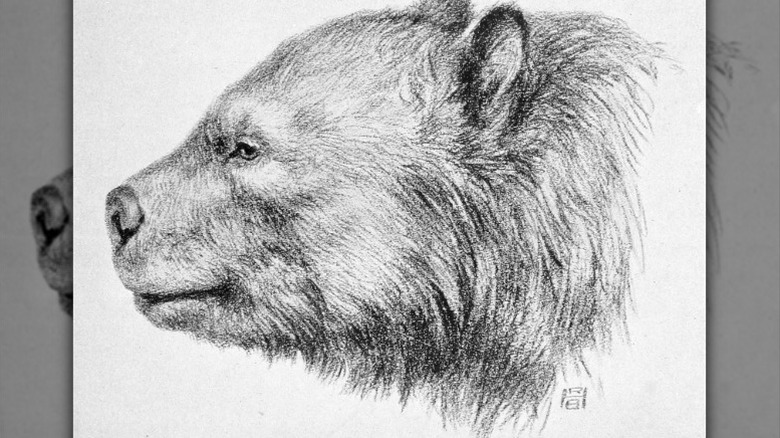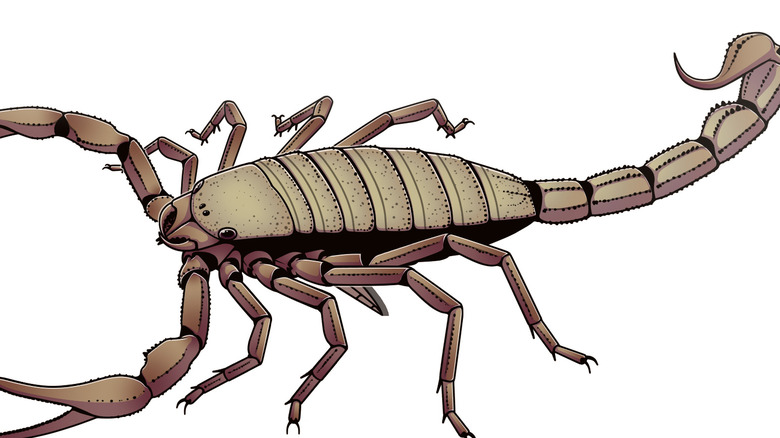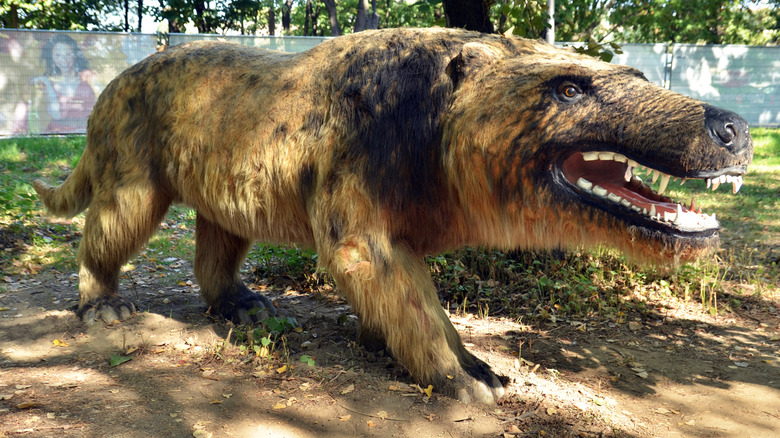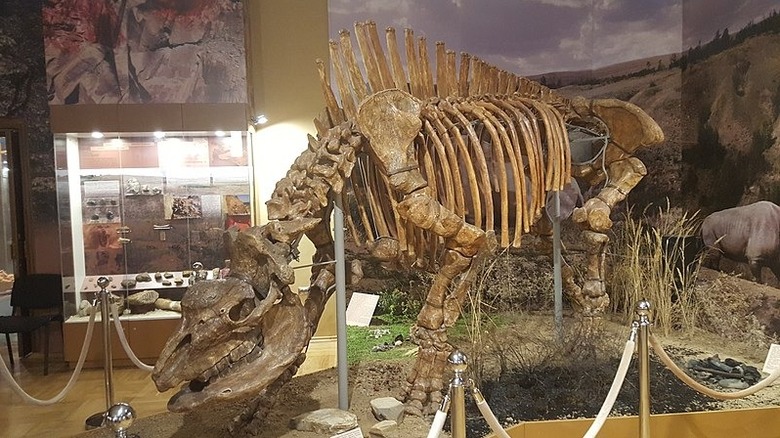11 Prehistoric Creatures That Are Pure Nightmare Fuel
When some of the more entrepreneurial lifeforms started moving from water to land some 390 million years ago, things soon got very interesting and haven't really stopped since. Just like many prehistoric sea animals were pure nightmare fuel, life on the drier corners of planet Earth has featured some truly shocking creatures over the years.
The discussion around the most terrifying land animals in history often revolves around dinosaurs, but the fact of the matter is that evolution has explored many other avenues over the years, as well. From mammals to insects, most groups of animals have managed to come up with particularly eerie specimens at some point in prehistory. As a result, even without involving dinosaurs in the mix, the following list is full of the kind of creatures today's most biodiverse ecosystems can only stare at in quiet terror. Let's explore some of the most nightmarish land-based prehistoric life forms in history.
Smilodon
Tigers and lions are one thing, but there's just something about a big cat that has massive, knife-like, canine teeth to go with the rest of the danger it poses. One of the many saber-toothed cats that roamed the Earth from 56 million years ago to just 11,700 years ago, Smilodon is often associated with the aforementioned two big felines today, and is indeed a member of a Felidae subspecies called Machairodontinae — unlike some other saber-toothed cats, who belonged in the entirely different Nimravidae family.
Size-wise, the Smilodons generally resembled a lion and could weigh 550 pounds, though the largest of them, Smilodon fatalis, could weigh 900 pounds. (For reference, the hulking Siberian tiger generally caps at 660 pounds.) A Smilodon's preferred method of predation was precisely what you think when you look at the animal. Its 8-inch canine teeth were not only long, but also serrated and extremely sharp, making them perfect weapons for hunting and cutting arteries. Its head and neck were specifically designed to bring these "saber" teeth down on the prey with a stabbing, slashing, flesh-rendering force, and its mouth could open an impressive 90 degrees for optimal biting.
Interestingly, some saber-toothed cats treated their deadly canines as concealed weapons, as they could hide their true size when they weren't actively using them. However, this wasn't an option for the Smilodon, which may have brought even mastodons down with its deadly canines.
Dire wolf
HBO's "Game of Thrones" may have made dire wolves — or "direwolves," as the show spelled them — famous, but the show's "regular wolf but bigger" approach is quite different from the real thing. Dire wolves, you see, very much existed in the prehistoric times, though you might not recognize one from George R.R. Martin's description. Formally known as Aenocyon dirus , these ancient beasts were indeed bigger than today's wolves, and their head was noticeably larger. However, they were actually more closely related to jackals than wolves, and they were the last representative of this particular type of canine.
Dire wolves lived in large packs during their Pleistocene Epoch heyday, and went extinct some 10,000 years ago. These groups of big predators hunted whatever they could sink their teeth into, including truly huge animals like bisons. We've known about these animals for quite some time since the remains of many specimens have been found in California's famed La Brea Tar Pits, as well as other areas in the Americas. The areas they have been found also explain why these fearsome canids were so different from the wolves we know; while grey wolves were a European fixture before eventually making their way to the Americas, dire wolves got their start in the Americas some 5 million years ago. This allowed evolution to take its course for millions of years without interaction with other, more wolf-like canid lineages.
Gigantopithecus blacki
Yeti. Bigfoot. Sasquatch. These and countless other legends of massive, bipedal, ape-like creatures skulking just out of humanity's sight make up a not insignificant portion of mankind's legends and conspiracy theories. While these cryptids have no explicit connection to their real-life prehistoric counterpart that we'll now study, fans of the theories surrounding their existence might be interested to know that a very similar creature once roamed the Earth.
This imposing primate was Gigantopithecus blacki, and it roamed many parts of Asia between 2 million years ago and up to 215,000 years ago. These juggernauts — which could be as big as 9.8 feet and 660 pounds — may have resembled modern orangutans, who come from a different branch of the same evolutionary homind direction. There's still much we don't know about this prehistoric giant, since the confirmed remains that have been discovered so far are exclusively teeth and bits of jaw. However, researchers have been able to use these finds to calculate Gigantopithecus blacki's size and surmise that it was probably a herbivore that lived in the forests — further adding its similarities to Sasquatches and Yetis of legend.
Western scientists found out about Gigantopithecus blacki in the 1930s when they discovered that a Hong Kong pharmacy sold massive teeth that looked just human enough to give birth to the occasional theory of ancient giant humans. Eventually, their true nature was discovered, and fossilized parts of the species have been found in several areas of Asia.
Arthropleura
When it comes to things you'd like to encounter during a fun day at the beach, a massive myriapod that looks like a millipede that invested its life savings in spiky body armor probably won't make it to the top of the list. Fortunately, these Arthropleura creatures haven't been around in millions of years, but as the biggest, nightmarish, land-based invertebrates science knows about, they certainly left their mark in (pre)history.
First, some measurements of the creature crawling about in the above image. Based on Arthropleura fossil discoveries, they could be up to 8 feet, 6 inches long and weighed an estimated 110 pounds. Some think that this absurd size was possible simply because there were no suitable predators to hinder the creature's growth, while others have suggested that the atmosphere's oxygen levels during the Arthropleura's heyday — roughly from 300 million years ago to 250 million years ago — were far higher than they are today, which enabled insects to grow extremely large. Regardless of the reason, these giant critters certainly existed back in the day. Scientists think that they lived on swamps, beaches, and even forest areas of Europe and North America.
Arthropleura may have scavenged things like seeds and other edible treats for food, but some have also suggested that they could have been predators themselves, feeding on other animals to facilitate their horrifying growth. Either way, encountering one or more of these oversized critters in the wild must have been a nasty experience.
Titanoboa
Giant snakes are a long-standing creature feature mainstay that dates back to actual ancient belief systems — such as the massive serpent Jörmungadr of Norse mythology. This is no surprise considering the general unnerving nature of snakes, not to mention the fact that large snakes like boas and anacondas very much exist even today (one terrifying specimen found in India was even larger than a bus).
As it happens, this is the type of common legend that's based on awful, awful reality, whether the people who tell the stories realize it or not. That reality's name is Titanoboa cerrejonensis – or just Titanoboa for short — and its imposing size blows many of its contemporary and even fictional counterparts out of the water.
A fearsome creature that lived sometime between 66 to 56 million years ago, the Titanoboa could be over 42 feet long and weighed 2,500 pounds. A predator that stalked its prey in the massive wetland areas that used to be near the Andes, this massive snake thrived in the hot climate of the Paleocene Epoch, and was so big that its remains were originally hard to recognize as snake bones. "We'd had some of them for years," paleontologist Jonathan Bloch from the University of Florida told Smithsonian Magazine. "My only excuse for not recognizing them is that I've picked up snake vertebrae before. And I said, 'These can't be snake vertebrae.' It's like somebody handed me a mouse skull the size of a rhinoceros and told me 'That's a mouse.' It's just not possible."
Meganeura
Meganeura are far from the deadliest creatures on this list, but their very existence is enough to remind you of all the books, comics, movies, and TV shows that feature giant insects that harass the protagonist. To fully paint a picture of how disturbing this ancient insect truly was, first imagine a dragonfly. It's pretty big as insects go, and you probably wouldn't want one zooming around you ... let alone fly directly at your face.
Meganeurides were like that, only they rocked a wingspan that could be as big as 28 inches. That's larger than that of a particularly big sharp-shinned hawk, and as it happens, Meganeurides filled a similar niche back in the day as raptor birds do now. They were predators with excellent eyesight and strong mandibles to capture prey, and preferred to stalk comparatively open areas — in their case, marshlands. Proponents of the theory that the atmosphere's high oxygen levels during the Carboniferous period — which also gave rise to the huge Arthropleura — have suggested that the Meganeura grew to its massive size thanks to the era's abundant oxygen, as well.
Inostrancevia
Every once in a while, a student of prehistoric creatures comes across a beast that seems like it would work better as a steed in a big budget sci-fi movie than any actual living animal that ever walked the same Earth we do. It doesn't have to be particularly frightening-looking, but there's just something a little bit off about it. Inostrancevia fits this bill extremely well in the sense that it looked like a special effects designer mixed and matched a Komodo dragon and a lion to create a beast that's both utterly alien and just familiar enough to get away with.
This peculiar creature had an angular head that resembled that of a reptile, an elephant-like hide, and the size, build, and massive sharp teeth of a saber-tooth tiger. Inostrancevia was an apex predator that belonged in the Gorgonopsia group of animals that weren't quite mammals but already had some of their traits. They terrorized the land at the end of the Permian period roughly 252 million years ago, but fell victims to the global warming that ended the period in a mass extinction event.
Arctotherium
A gigantic bear is rarely good news for whoever happens to run across its path. This goes double for Archtotherium angustidens, the massive bear beast that lived in South America between 2.6 million and 500,000 years ago. To get a proper idea of its size, let's first look at today's hulking polar bears, which can sometimes weigh 2,200 pounds. The largest Archtotherium angustidens fossil researchers have found used to be an animal that may have weighed as much as 3,855 pounds, and was about 11 feet tall when standing on its hind legs.
"During its time, this bear was the largest and most powerful land predator in the world," paleontologist Blaine Schubert of East Tennessee State University in Johnson City said in an interview with LiveScience. "It's always extremely exciting to find something that's the largest of its class — and not just a little bit larger, but quite a bit larger."
Researchers think that meat formed the bulk of the giant short-faced bear's diet, and that its sheer size and power enabled it to bring down huge prey animals that included ancient elephants and giant sloths. However, life wasn't always smooth sailing for it. You'd think that a bear this size has little to fear, but the aforementioned 2,200-pound specimen actually had to deal with some nasty injuries during its life — presumably from fights with its massive prey or other large predators.
Pulmonoscorpius kirktonensis
Scorpions are no one's idea of a good time, but imagine if they were many times the size of the biggest one living today? Sure, there wouldn't be a risk of finding one in your shoe, but on the other hand, a scorpion the size of a dog might be tempted to wear the shoe instead.
Pulmonoscorpius kirktonensis was essentially what you think of as a scorpion today — only, it was over 27 inches long. Like other unseemly large creepy-crawlies on this list, it lived during the end of the Carbonifeurus period, possibly growing to its impressive size due to the oxygen-heavy makeup of the atmosphere. It had comparatively small pincers, which often correlates with a stronger venom in modern scorpions — a worrying possibility considering the imposing size of their prehistoric cousin.
Apart from its size, much of what we know about Pulmonoscorpius kirktonensis is educated speculation that relies on its similarity with modern scorpions. There's always the possibility that its pincers could simply be small because it focused on tiny prey, and that its venom wasn't all that dangerous. Still, it's worth noting that modern scorpions are invariably carnivorous, and many of the comparatively thick-tailed species with small pincers (much like Pulmonoscorpius has) roam the land and chase whatever prey they find. It's all too easy to believe that their prehistoric relative wasn't any less ruthless.
Andrewsarchus mongoliensis
Andrewsarchus mongoliensis looks like someone took a 4-year-old's drawing of the angry dog next door and turned it into an apex predator, and the story behind its discovery is as curious as its appearance. The only specimen we know was found by paleontological assistant Kan Chuen Pao during the American Museum of Natural History's 1923 expedition to Mongolia, and named after the group's leader Roy Chapman Andrews. Defining the animal's origin was somewhat contentious, and at some point, a member of the expedition was convinced that the animal was an ancient pig.
There's still a certain amount of speculation surrounding the Andrewsarchus. A 3-foot-long skull full of impressive teeth is all that's ever been found of the animal, but based on that, researches have been able to figure out quite a few things about this strange animal ... including the fact that it's an artiodactyl, which makes it a relative of both land animals like the hippopotamus and the marine artiodactyls that became whales. This, at the very least, goes some way toward explaining the stocky but streamlined figure Andrewsarchus may have had.
As its gaping maw strongly suggests, Andrewsarchus is thought to have been a predator — and a fairly significant one, too. In fact, if the estimations that it was 12 feet long and 6 feet high are correct, It's actually the largest carnivorous mammal that has ever lived on land.
Elastmotherium
Imagine the woolly mammoth, but as a rhino. Well done! You've now gone a long way toward picturing the mighty Elastmotherium, a stocky and hair-covered ancient mammal that was essentially an even more impressive version of the better-known woolly rhinoceros, aka Coelodonta.
The Coelodonta was no slouch when it came to sheer size, as it could be up to 12.5 feet long. However, it pales in comparison with the Elastmotherium, an animal that could grow up to 20 feet long and rocked a horn that might have been as long as six feet. Unlike Coelodonta, Elastmotherium also looked quite different from a contemporary rhino — apart from its imposing size, it also had a distinctive hump that added to its bulky look.
Despite its curious look, Elastmotherium is actually one of the more recent animals on this list, and it's possible that it didn't go extinct until some 39,000 years ago — roughly the same time as the Neanderthals did. Its threatening look likely belied a reasonably peaceful herbivore that was content to hang around and graze on grass. However, if some other creature happened to sufficiently annoy it, there was trouble ahead; despite being built like a horned tank, Elastmotherium was quite a fast runner.
